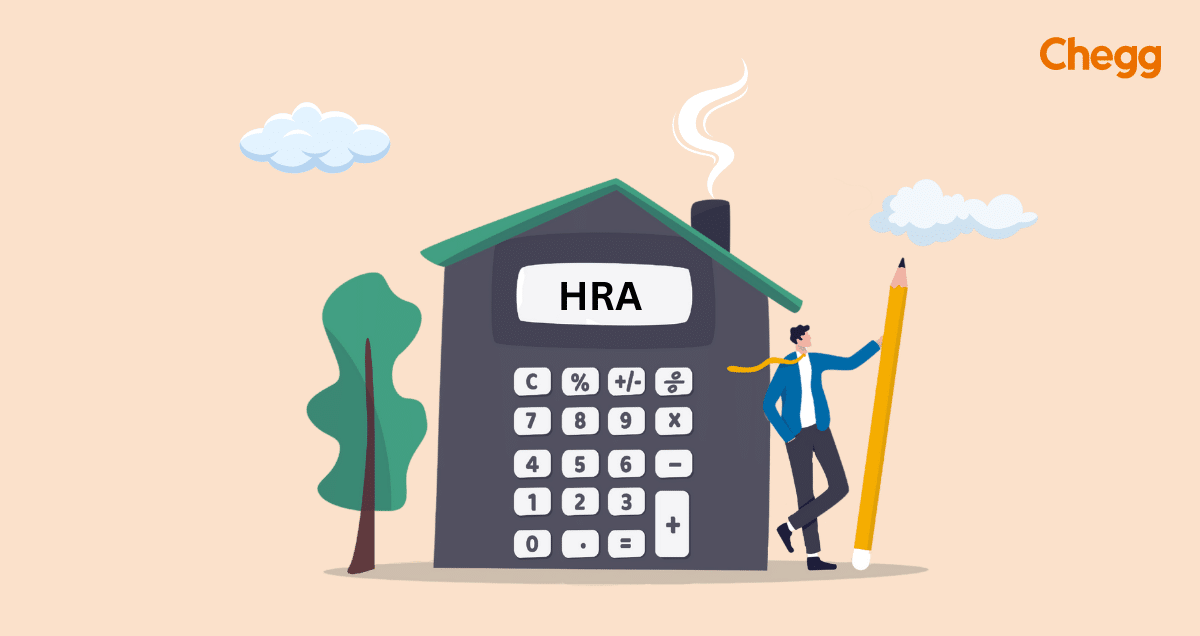How to Calculate HRA in Salary: Simplified Calculation
House Rent Allowance (HRA) is an integral part of an employee’s salary provided by the company or employer. With the rising cost of living and rent, HRA plays a crucial role in supporting employees’ financial well-being. By understanding how to calculate HRA in salary, you can minimize your tax liability and maximize your savings. In […] The post How to Calculate HRA in Salary: Simplified Calculation appeared first on Chegg India.

House Rent Allowance (HRA) is an integral part of an employee’s salary provided by the company or employer. With the rising cost of living and rent, HRA plays a crucial role in supporting employees’ financial well-being. By understanding how to calculate HRA in salary, you can minimize your tax liability and maximize your savings.
In India, HRA is governed by the Income Tax Act, specifically Section 10(13A). This act outlines exemptions and provides guidelines for calculating and taxing HRA based on income. The amount of HRA an employee receives is typically proportional to their basic salary, and the government sets a minimum limit for HRA. Other factors influencing HRA include the city of residence and the employer’s policy.
How is HRA Calculated in Salary
To claim a House Rent Allowance (HRA) exemption, employees need to submit certain documents as proof of rental payments, including rent receipts and lease agreements. The HRA exemption significantly reduces the tax burden on employees, making it a valuable benefit.
Let’s explore how to calculate HRA in salary with the example:
- HRA Calculation in Metro Cities: Let’s consider an employee named Neha, who works in a metropolis with a basic monthly salary of Rs. 80,000. In metro cities, the law states that an employee will receive 50% of their basic salary as HRA. So, Neha’s HRA would be Rs. 40,000 per month.
- HRA Calculation in Non-Metro Cities: Now, let’s consider another employee, Ranbir, who resides in a non-metro city for work. His basic salary is Rs. 50,000 per month. According to the law, he will receive 40% of his salary as HRA. Therefore, Ranbir’s HRA would amount to Rs. 20,000 per month.
How to Calculate Tax Exemption on HRA
Now, let’s understand the HRA calculation for tax exemption on HRA:
The HRA calculation for tax exemption is based on three factors:
- Actual HRA Received: This refers to the actual amount of HRA received by the employee from the company or employer.
- 50% of Basic Salary (In Metro Cities): In metro cities, employees receive HRA equivalent to 50% of their basic pay.
- 40% of Basic Salary (In Non-Metro Cities): In non-metro cities, where the cost of rent is relatively lower, employees receive 40% of their basic pay as HRA.
The tax exemption on HRA is determined by the minimum of these three calculations. Here’s an HRA exemption calculation example:
Example for Metro Areas
Let’s consider an employee named Sadiq, working in a metropolis with a basic salary of Rs. 100,000 per month. The HRA provided by the employer is Rs. 50,000 per month, and Sadiq pays Rs. 40,000 per month as rent.
Calculation: Actual HRA received = Rs. 50,000 per month
Rent Paid – (10% of Basic Salary Received) = Rs. 40,000 – (10% of Rs. 100,000) = Rs. 30,000
50% of Basic Salary = 50% of Rs. 100,000 = Rs. 50,000
The minimum amount among these calculations is Rs. 30,000. Therefore, after the HRA exemption calculation, the taxable amount would be Rs. 20,000 (Rs. 50,000 – Rs. 30,000).
Example for Non-Metro Areas:
To understand the concept of HRA in a non-metro city, let’s consider an employee named Dinesh, who works in a non-metro city with a basic salary of Rs. 50,000 per month. The HRA provided by the company or employer is Rs. 20,000 per month, and Dinesh pays Rs. 10,000 per month as rent.
Now, let’s determine Dinesh’s HRA exemption based on this information:
Calculation: Actual HRA received = Rs. 20,000 per month
Rent Paid – (10% of Basic Salary Received) = Rs. 10,000 – (10% of Rs. 50,000) = Rs. 5,000
40% of Basic Salary = 40% of Rs. 50,000 = Rs. 20,000
The minimum amount among these calculations is Rs. 5,000. Therefore, after the HRA exemption calculation, the taxable amount would be Rs. 15,000 (Rs. 20,000 – Rs. 5,000).
In this scenario, Dinesh would be eligible for an HRA exemption of Rs. 15,000, and the remaining Rs. 5,000 would be taxable.

Eligibility Criteria for HRA Tax Exemption
To be eligible for an HRA tax exemption in India, certain conditions must be met:
- Employment and HRA Receipt: You must be employed and receive HRA from your employer.
- Payment for Accommodation: You should be paying for the accommodation where you reside.
- Valid Rent Documents: Valid documents proving rent payments are mandatory.
- Non-Family Owned Property: The rented property should not be owned by you, your spouse, or any family member.
- Taxable Salary: You must have a taxable salary.
- Home Loan and HRA: Even if you are on a home loan, you can avail of an HRA exemption.
Documents Required for Claiming HRA Exemption
To claim an HRA exemption, employees need to provide certain documents as proof. These may include:
- Rent Receipts: Valid rent receipts issued by the landlord, containing details such as the landlord’s name, rent amount, and signatures of both parties.
- Lease Agreement: A copy of the lease agreement signed between the tenant and landlord outlining the terms, conditions, and duration of the lease.
- Landlord’s PAN: If the annual rent paid exceeds Rs. 1 lakh, the PAN number of the landlord needs to be provided.
- Proof of Address: Any official document containing your residential address can serve as proof.
- Bank Statement: If rent payments are made through a bank transaction, providing the bank statement as additional proof is advisable.
Maximize Your Savings and Simplify HRA Calculation Using Excel
Maximizing your savings through HRA exemption is a strategic financial move for individuals residing in leased accommodations in India. House Rent Allowance (HRA) not only provides affordable housing options but also offers tax exemptions, enhancing your overall financial security. To make the most of this benefit, it’s crucial to understand how to calculate HRA in salary accurately. One convenient way to perform this calculation is by utilizing Microsoft Excel, a widely-used spreadsheet software.
By creating a simple Excel formula, you can easily calculate the HRA amount based on your basic salary. The formula typically involves multiplying a certain percentage of your basic salary by a factor that depends on whether you live in a metro or non-metro city. Excel allows you to automate this calculation, making it faster and more efficient.
To calculate HRA in Excel, you can create a cell reference for your basic salary and input the appropriate formula that incorporates the necessary percentages and factors. This way, whenever there are changes in your basic salary or the city of residence, the HRA amount will be automatically updated, saving you time and effort.
Utilizing Excel for HRA calculation not only streamlines the process but also allows for better financial planning. You can experiment with different scenarios, adjusting the basic salary, city factors, and percentages to determine the optimal HRA amount that maximizes your savings.
Calculate Your Budget with Ease!
HRA exemption is vital for employees who don’t have any accommodation facilities on their own. This is a blessing to the employees who live in both metro and non-metro cities as tenants. To know how to reduce your tax, you have to know about the HRA exemption.
Evaluate numerous career choices to choose the right career path for yourself. Dive in to our guide on Career Advice.
Frequently Asked Questions ( FAQ’s )
The House Rent Allowance (HRA) calculation formula is:
HRA = (Basic Salary * HRA Percentage) – (Rent Paid – 10% of Basic Salary)
To calculate HRA using a basic salary calculator, follow these steps:
a. Determine the HRA percentage provided by your employer, usually mentioned in your contract letter.
b. Identify your basic salary.
c. Calculate the total rent amount you pay for your accommodation.
d. Calculate 10% of your basic salary.
e. Use the HRA calculation formula mentioned above.
No, HRA is not calculated as a fixed percentage (12%) of the basic salary. It depends on various factors defined by the Indian government. In metro cities, employees receive HRA equivalent to 50% of their basic pay, while in non-metro cities, it is 40% of the basic pay.
The House Rent Allowance (HRA) percentage refers to the portion of the basic salary paid by the employer to the employee for accommodation purposes. In metro cities, employees receive HRA equivalent to 50% of their basic pay, whereas in non-metro cities, where the cost of rent is relatively lower, employees receive 40% of their basic pay as HRA.
Related Reads
The post How to Calculate HRA in Salary: Simplified Calculation appeared first on Chegg India.





















/cdn.vox-cdn.com/uploads/chorus_asset/file/25137937/236942_Nic_Cage_Interview2_CVirginia.jpg)





